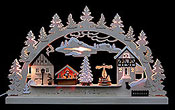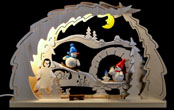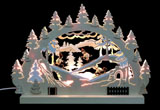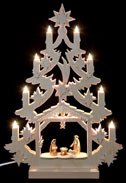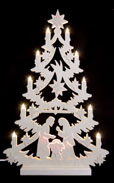All arches, except tree-shaped arches, now have LED
lighting.
|
During the Christmas
season, windows throughout the Saxony area of Germany are lit with the
soft lights of Schwibbögen, or Christmas arches. These
traditional displays reach back over 270 years to the silver mines of
the Erzgebirge in Germany, and the first Schwibbögen, made out of
wrought iron, are thought to have originated in the town of
Johanngeorgenstadt.
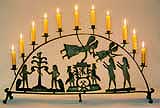
The oldest existing wrought iron
Schwibbogen is in Johanngeorgenstadt (1778)
|
|

After miners
finished a long, hard day in the
mines, they would hang their lanterns at
the mine entrance. The twinkling lights
formed a glittering arch, and these lantern
arches are thought to have been the
inspiration for Schwibbögen. |
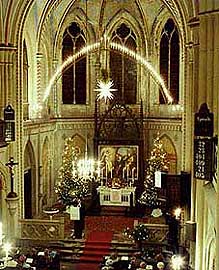
The largest Schwibbogen in the world in the church in
Johanngeorgenstadt |
|
Schwibbögen were especially
popular during the Christmas season. Christmas was the
only time in the year when the hard and
dangerous work in the mines came to
a rest. Wives put the Schwibbögen in their
cottage windows and lit the candles to
welcome their husbands home after a hard
day in the mines. The twinkling lights in the
windows guided the miners as they trudged
through darkness and snow, and welcomed
them to the warmth and security of their
homes and families.
During the Christmas season,
large Schwib-
bögen are also set up in the public squares
and churches in the Erzgebirge.
Home craftsmen soon began to
work with
wood because of its natural beauty and
warmth. The making of Schwibbögen
quickly became an important source
of income throughout the Erzgebirge.
Schwibbögen were carved in homes and
decorated with candles. Today, the
candles are often replaced with tiny
electric lights. |
|
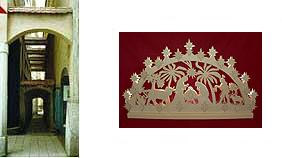
Schwebebogen and a modern wood Doppelschwibbogen |
|
The name Schwibbogen also seems to
have an architectural meaning. During the
Gothic age a freestanding arch between
two supporting walls was called a
Schwebebogen.
Schwibbögen Bring Christmas
Tradition into your Home
Schwibbögen are part of the woodcarving
tradition of the Erzgebirge region, and
nowadays the Schwibbögen, just as the
nutcracker and the Christmas pyramid,
have become known worldwide as symbols
of Christmas folk art. |
Doppelschwibbögen (Double Arches)
Over the years Schwibbögen have
taken on numerous shapes and sizes. They appear
with exquisitely carved figures and designs, whose beauty is enhanced with
electric
lights or candles. A recent development is the creation of
Doppelschwibbögen, or
double arches. With indirect electric lighting, the design silhouette is
brought into the
foreground with a fascinating play of light. The Doppelschwibbögen you see
here are
made by hand in a small, family-owned factory in the Saxony region of
Germany.
This small factory rejects mass production, and every piece is handcut.
The electric
lights are also added by hand.
No laser, water stream, or
computer-controlled technology is used.
Each Schwibbogen is
accompanied by a label guaranteeing that it is handcrafted.
|
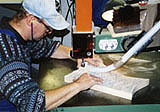
A craftsman cuts
the arches by hand |
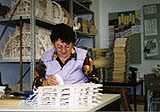
Adding the electric lights |
Christmas Designs
Doppelschwibbögen come in a variety of Christmas
designs -- everything from Christmas market scenes to sledders to
whimsical snowmen.
Doppelschwibbögen are also available as Christmas
tree designs.
A Schwibbogen will light your home with all the warmth and joy
of the Christmas season.
|





